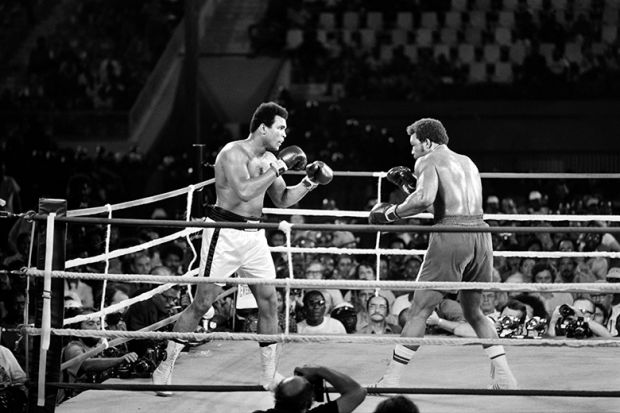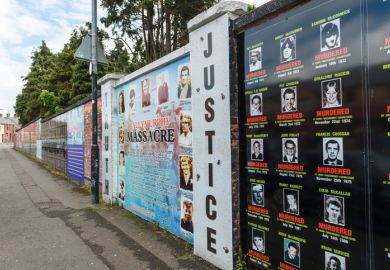It’s hard to believe that a boxing match will ever again encapsulate a historical moment in the way that the 1938 rematch between Joe Louis and Max Schmeling, or the 1974 title fight between Muhammad Ali and George Foreman, once did. In The Greatest Fight of Our Generation (2006) and now in The Rumble in the Jungle, Lewis Erenberg has written definitively about both these fights. Drawing on a much wider than usual range of primary sources (in particular, newspapers), he considers why these particular sporting events so powerfully captured the distinctive American and, to some extent, “global” tensions of their time.
In 1938, most white Americans read the political message of Louis’ knockout of Schmeling in straightforward terms – as the American defeat of German fascism. For blacks, however, the message was more complex, for they knew all too well that Louis was fighting in (as well as for) Jim Crow America. Observing the rapturous “High Tide in Harlem” that followed the 124-second contest – half a million blacks took to the streets, shouting “Heil Louis!” – Richard Wright wondered when African Americans might break out of the confines of their own square circle and recognise that “the earth was theirs…they did not have to live by proscription in one corner of it”.
If, by 1974, that question was more urgent than ever, the political allegory of Ali versus Foreman was very different. For a start, both boxers were black Americans, and they fought each other in the newly independent republic of Zaire.
The symbolism relied heavily on the fighters’ backstories. Ali’s was more familiar. In 1960, after winning an Olympic gold medal, Cassius Clay told a Soviet journalist that the US was “the best country in the world counting yours”, but by 1964 he had become world heavyweight champion and a prominent member of the Nation of Islam who demanded to be known as Muhammad Ali. And just three years later, he was stripped of his title and convicted of draft evasion, having declared his opposition to fighting the Viet Cong.
By then, the ring was only one of many platforms for a man Erenberg dubs “fighter-poet, fighter-preacher, fighter-comic, fighter-public presence”. Ali became a hero for both the anti-war movement (demonstrating how refusing to fight could be manlier than going) and for the burgeoning Black Power movement, in particular for what the sociologist and activist Harry Edwards termed “the revolt of the black athlete”. A generation earlier, athletes such as Joe Louis, Jackie Robinson and Jesse Owens had simply fought for sports to be integrated; by the late 1960s, Ali and others were challenging the terms of that inclusion. The revolt reached its apotheosis at the 1968 Olympics in Mexico City, when the sprinters Tommie Smith and John Carlos used the medal podium to give a Black Power salute.
Another medal winner was a young heavyweight called George Foreman. He celebrated, however, by waving and kissing a small American flag – not as a counter-protest, he claimed, but simply because “it’s my flag”. It was a gesture, Erenberg points out, that was easy to misinterpret. The presidential candidate Richard Nixon thought it meant that Foreman was unafraid to “show his patriotism” and invited him to join his campaign. He did not, however, pay attention to another sign that the boxer had displayed. Embroidered on the back of Foreman’s robe was the legend “The Fighting Corpsman”, a reference to the Jobs Corps, one of the key initiatives of Lyndon Johnson’s War on Poverty, and still in existence. Even today, Foreman is keen to credit the programme with changing his life – introducing him to boxing but also, more importantly, giving him “three meals a day and a chance”. It was, therefore, hardly surprising that in 1968 he campaigned for Hubert Humphrey, one of the architects of the corps, rather than Nixon, who pledged to cut it. But, of course, this kind of distinction between liberals and conservatives was not what sold tickets. Since Ali promoted himself as the rebellious spirit of both youthful America and pan-Africanism, Foreman had to be reduced, in Ali’s words, to “Christianity, the flag, the White Man, Pork Chops”.
The third protagonist in the drama was its setting, Zaire. The fight’s promoter, Don King, capitalised on both black America’s interest in all things African and the desire of Mobutu Sese Seko’s government to showcase the nation as both modern and “authentic”, not least to attract foreign investment. The Rumble – “a fight between two Blacks in a Black Nation, organized by Blacks and seen by the whole world”, as King put it – was the main event, but it was preceded by a three-day music festival featuring black musicians from Africa, the US and the Caribbean, with James Brown as the headline act. Since the match was postponed (because Foreman suffered a cut), the festival was poorly attended and, compared with the fight itself, it has been little discussed. Erenberg rightly devotes a chapter to this pioneering “superevent”.
From the point of view of high drama, the fight itself could not have gone better. Foreman was 3-1 favourite, and so Ali’s unexpected victory (a dramatic knockout in the eighth round) was particularly exciting and intriguing. By lying back on the ropes and protecting his head until Foreman tired himself out, he claimed to have invented a new technique, the “rope-a-dope”. In fact, it was a classic defensive strategy, and for Puerto Rican boxer José Torres, what was most admirable was Ali’s subsequent skill in “patenting” it as his own.
Coming just a few months after Nixon’s resignation, Ali’s victory seemed to represent a “momentary redemption of the rebellious values of the 1960s”, Erenberg writes. But on a longer scale, the story is one of accommodation. In 1975, Gerald Ford invited Ali to the White House as part of his Lincolnesque attempt to “heal the wounds of racial division, Vietnam and Watergate”, and the following year, Ali campaigned for Jimmy Carter, who sent him to Africa to gather support for a boycott of the Moscow Olympics. When, on a visit to the Soviet Union in 1978, Ali described America as “the best country in the world” (the exact phrase he had used in 1960), it was almost as if the past 18 years had not happened. And after the World Trade Center attack in 2001, Ali appeared on TV urging America’s Muslims to support the war effort. Foreman, meanwhile, had his own conversions – in 1977, after another defeat in the ring, he was born-again as a Christian and gave up boxing to work as a preacher. He later returned to the ring and, to general astonishment, regained the heavyweight title in 1994. Today, however, because of his endorsement of the Lean Mean Grilling Machine, he is best known, in Erenberg’s description, as a “knockout entrepreneur”.
But the story Erenberg traces is not the fall from some mythical moment “when we were kings”. Money was always at the heart of the matter. What the Rumble best demonstrates is how the advent of satellite technology and closed-circuit ticketed telecasts produced the lucrative global sports market we still live with. The fight’s intended audience was not 60,000 Zairians in a Kinshasa stadium but millions of viewers in 120 nations, the most important of all (as indicated by the 4am start time) being in the US. Boxing – or rather Ali – was not simply a beneficiary of this new brave new world, but its driver.
Kasia Boddy is reader in American literature at the University of Cambridge. A new edition of her book Boxing: A Cultural History (Reaktion) is out this summer.
The Rumble in the Jungle: Muhammad Ali and George Foreman on the Global Stage
By Lewis A. Erenberg
University of Chicago Press
298pp, £30.00
ISBN 9780226059433
Published 28 May 2019
The author
Lewis A. Erenberg, emeritus professor of history at Loyola University, Chicago, was born and raised in East Los Angeles, where he recalls going to school with “kids from Jewish, Mexican, Japanese and African American backgrounds struggling under adverse circumstances to make their way in a dangerous environment”. He studied history at the University of California, Los Angeles, where courses on social and intellectual history with the late Donald B. Meyer opened his eyes to “the history of gender, of African Americans and other minorities, as well as the vital role that entertainment and popular culture have played in American life”.
Going on to a PhD at the University of Michigan, therefore, Erenberg began the research that eventually led to his books Steppin’ Out: New York Nightlife and the Transformation of American Culture, 1890-1930 (1981) and Swingin’ the Dream: Big Band Jazz and the Rebirth of American Culture (1998). By the time the latter was published, however, other scholars were producing important work in this area and he “felt that I had said all I could about the history of American entertainment”. Yet the study of sport “still operated at the margins”, even though it provided “a powerful vehicle for exploring hidden and overlooked areas of American culture”.
Such themes are examined historically in both The Greatest Fight of Our Generation: Louis vs. Schmeling (2006) and now The Rumble in the Jungle. Today, Erenberg explains, football, basketball and boxing “continue to recruit minority athletes [and so] suggest that the American Dream is still vital”, yet “the head coaches and executives are overwhelmingly white…As with Muhammad Ali, sport is a platform for politically aware black athletes to protest the treatment of ordinary black people, but at the same time, this impulse remains in tension with the rewards that come with keeping quiet.”
Matthew Reisz
POSTSCRIPT:
Print headline: The big event that floored the world
Register to continue
Why register?
- Registration is free and only takes a moment
- Once registered, you can read 3 articles a month
- Sign up for our newsletter
Subscribe
Or subscribe for unlimited access to:
- Unlimited access to news, views, insights & reviews
- Digital editions
- Digital access to THE’s university and college rankings analysis
Already registered or a current subscriber? Login






